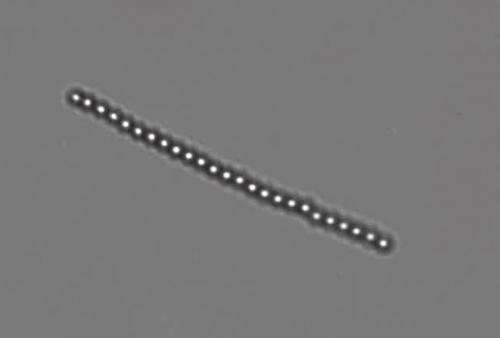'Kinks' in tiny chains reveal Brownian rotation

(PhysOrg.com) -- Rice University researchers have created a method to measure the axial rotation of tiny rods. The technique detailed in a paper by Sibani Lisa Biswal and her colleagues appears this month in the journal Physical Review Letters.
Biswal, an assistant professor in chemical and biomolecular engineering, said it's easy to view microscopic rods as they wiggle and weave under the influence of Brownian forces. But it's never been easy to see one spin along its axis, let alone measure that motion.
The technique created by Biswal and her team involves micron-scale rigid chains in liquid that act like perfect cylinders as they exhibit Brownian motion. But the rodlike chains incorporate the slightest of imperfections. These nearly invisible "kinks" are just big enough to the measure the chain's rotation without influencing it.
Knowing how elongated molecules move in a solution is important to those who study the structure of liquid crystals or biological processes like the dynamics of lipid bilayers, the gatekeepers in living cells, Biswal said.
The research follows her lab's creation of a technique to build stiff chains of particles that mimic rod-like polymer or biological molecules. Using them like Legos, the lab assembles chains from DNA-grafted paramagnetic polystyrene particles, which line up when exposed to a magnetic field and link together where the strands of DNA meet.
The result looks like a string of beads. Depending on the length and type of the DNA linkers, the rods can be stiff or flexible. Slight variations in the paramagnetic properties of each particle account for the kinks. "We can make them robust; we can make them stable," Biswal said. "Now we're actually using them as a model for polymer chains."
It's long been known that stiff rods in a solution rotate as they dance and are pushed by the atoms around them. Nearly two centuries ago, Robert Brown observed the rotation of flat arsenic trioxide flakes but had no way to characterize that motion. While Albert Einstein and others have since made progress in applying formulas to Brownian motion, the particulars of rotation have remained a relative mystery.
Dichuan Li, a graduate student in Biswal's lab and lead author of the new paper, was inspired to look at rotation after reading Brown's 1827 report in a classic-paper reading club. "He noticed what he thought must be axial rotation, but he wasn't able to measure how fast it was moving," Li said.
The new method is the first systematic approach to measuring the axial rotation of particles, he said. Once chains are formed, the magnetic field is released and the chains are free to move in a solution between two cover plates. Li isolated and filmed the structures as they twisted, and he later analyzed the kinks to quantify the chains' motion.
The finding opens a door to further study of longer or more complex polymer or biological chains, Biswal said. She said the paramagnetic beads could be used to model rods of varying stiffness, "even more flexible structures that can actually curve and bend, just like DNA, or branch-like structures. Then we can apply forces to them and see what happens."
Biswal hopes to take a closer look at how polymers entangle in materials of varying density. "How they're stabilized by entanglement is not well understood," she said. "We're moving toward being able to create not just single chains for study, but large collections of these chains to see if they provide good models to look at things like entanglement."
More information: Axial Thermal Rotation of Slender Rods, Phys. Rev. Lett. 106, 188302 (2011). DOI: 10.1103/PhysRevLett.106.188302
Abstract
Axial rotational diffusion of rodlike polymers is important in processes such as microtubule filament sliding and flagella beating. By imaging the motion of small kinks along the backbone of chains of DNA-linked colloids, we produce a direct and systematic measurement of axial rotational diffusivity of rods both in bulk solution and near a wall. The measured diffusivities decrease linearly with the chain length, irrespective of the distance from a wall, in agreement with slender-body hydrodynamics theory. Moreover, the presence of small kinks does not affect the chain’s axial diffusivity. Our system and measurements provide insights into fundamental axial diffusion processes of slender objects, which encompass a wide range of entities including biological filaments and linear polymer chains.
Provided by Rice University




















